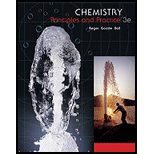
Concept explainers
(a)
Interpretation:
The species, which have stronger bonds between,
Concept Introduction:
Bond energy:
The bond order is the number of electrons pairs shared between two atoms in the formation of the bond. The amount of energy required to break a bond is called
Bond order
Where,
(a)
Answer to Problem 10.94QE
The bond in fluorine molecule is stronger than the
Explanation of Solution
The molecular electronic configuration of fluorine molecule is,
The number of electrons in the bonding orbital=10
The number of electrons in the antibonding orbital=8
Bond order of fluorine molecule can be calculated as,
Bond order
The molecular electronic configurations of
The number of electrons in the bonding orbital is ten.
The number of electrons in the antibonding orbital is nine.
Bond order of
Bond order
The bond order of
(b)
Interpretation:
The species that have stronger bonds between
Concept Introduction:
Refer to part (a).
(b)
Answer to Problem 10.94QE
The bond in
Explanation of Solution
The molecular configuration of
There are ten electrons in bonding orbital and seven electrons antibonding orbitals.
Bond order of
The molecular configuration of
Bond order of
Bond order of
The bond order of the
(c)
Interpretation:
The species, which have stronger bonds between,
Concept Introduction:
Refer to part (a).
(c)
Answer to Problem 10.94QE
The bond in
Explanation of Solution
The
The electronic configuration of
The molecular electronic configuration of
There are six electrons in bonding and four electrons in antibonding orbitals.
The molecular electronic configuration of
The number of electrons in the bonding orbital is six and the number of electrons in antibonding orbital is 4.
Bond order
The bond order of the
Want to see more full solutions like this?
Chapter 10 Solutions
Chemistry
- Identify the hybridization of each underlined atom in the following compounds and ions: (a) B_H4 (b) H2C_=C_HC_H3 (c) BCl3arrow_forwardExplain in terms of bonding theory why all four hydrogen atoms of allene, H2CCCH2, cannot lie in the same plane.arrow_forwardIdentify the orbitals on each of the atoms that form the bonds in H3CCN. How many bonds and bonds form?arrow_forward
- 3. Which of the following molecules has a dipole moment? A CCH B. O2 C. NH3 D. CO2arrow_forwardA student claims that if element D is in group 18, then the molecular geometry of DF4(g) is square planar. Do you agree or disagree with the student? Justify your answer in terms of the VSEPR theory.arrow_forwardA.) What is the electron geometry of IF5? B.) What is the molecular geometry of IF5? C.) Ignoring lone-pair effects, what is the smallest bond angle in IF5?arrow_forward
- Which of the following is trigonal planar? a. boron trifluoride, BF3 b. methyl anion, CH3− c. methane, CH4 d. ammonia, NH3 Group of answer choices a b c darrow_forwardShown below is the molecular orbital diagram for N2. Does N2+ have a shorter or longer bond length?arrow_forwardProvide Lewis structures, electronic pair geometry and hybridization atoms marked in bold in the following molecules: A. H2CCCH2 B. Cl O 3 c. N O 3 d. O C Cl 2arrow_forward
 Chemistry: Principles and PracticeChemistryISBN:9780534420123Author:Daniel L. Reger, Scott R. Goode, David W. Ball, Edward MercerPublisher:Cengage Learning
Chemistry: Principles and PracticeChemistryISBN:9780534420123Author:Daniel L. Reger, Scott R. Goode, David W. Ball, Edward MercerPublisher:Cengage Learning Chemistry & Chemical ReactivityChemistryISBN:9781133949640Author:John C. Kotz, Paul M. Treichel, John Townsend, David TreichelPublisher:Cengage Learning
Chemistry & Chemical ReactivityChemistryISBN:9781133949640Author:John C. Kotz, Paul M. Treichel, John Townsend, David TreichelPublisher:Cengage Learning Chemistry & Chemical ReactivityChemistryISBN:9781337399074Author:John C. Kotz, Paul M. Treichel, John Townsend, David TreichelPublisher:Cengage Learning
Chemistry & Chemical ReactivityChemistryISBN:9781337399074Author:John C. Kotz, Paul M. Treichel, John Townsend, David TreichelPublisher:Cengage Learning Chemistry: The Molecular ScienceChemistryISBN:9781285199047Author:John W. Moore, Conrad L. StanitskiPublisher:Cengage Learning
Chemistry: The Molecular ScienceChemistryISBN:9781285199047Author:John W. Moore, Conrad L. StanitskiPublisher:Cengage Learning General Chemistry - Standalone book (MindTap Cour...ChemistryISBN:9781305580343Author:Steven D. Gammon, Ebbing, Darrell Ebbing, Steven D., Darrell; Gammon, Darrell Ebbing; Steven D. Gammon, Darrell D.; Gammon, Ebbing; Steven D. Gammon; DarrellPublisher:Cengage Learning
General Chemistry - Standalone book (MindTap Cour...ChemistryISBN:9781305580343Author:Steven D. Gammon, Ebbing, Darrell Ebbing, Steven D., Darrell; Gammon, Darrell Ebbing; Steven D. Gammon, Darrell D.; Gammon, Ebbing; Steven D. Gammon; DarrellPublisher:Cengage Learning




